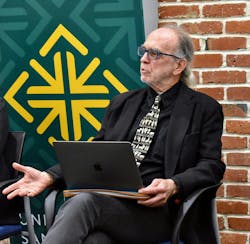An effort that began in 2018 with the passage of SB 1339, legislation to commercialize microgrids in California, appears to have met a final roadblock with a proposed California Public Utilities Commission (CPUC) decision rejecting tariff proposals from nonutility stakeholders.
This deals yet another blow to meeting the state’s aggressive climate goals, the nonutility stakeholders say.
An important goal of SB 1339 was to create a tariff for multiproperty or community microgrids that would make them financially viable. Community microgrids are seen as key to the energy transition because they allow for local energy to be consumed by the parties inside the microgrid, lowering transmission costs and potentially increasing the use of renewable energy.
Wanted: an energy future of community microgrids operating 24/7
“When I think about the energy future, we want to be able to form multicustomer microgrids that can operate 24/7 where you’re using the internal resources to serve the internal load and reduce what you take from the grid,” said Lorenzo Kristov, an advisor to The Climate Center who specializes in electric system policy, structure and market design.
On September 17, the CPUC issued a proposed decision rejecting proposals from nonutility stakeholders to implement tariffs that they argue would make community microgrids commercially viable.
Nonutility stakeholders say the CPUC’s proposal won’t commercialize microgrids
In February, those stakeholders submitted to the CPUC proposals that differ dramatically from the CPUC’s proposal. The commission wants to base the community microgrid tariff on a Pacific Gas & Electric (PG&E) program– the Community Microgrid Enablement Program (CMEP).
The stakeholders argue that CMEP hasn’t yielded any community microgrids, except for the Redwood Coast Airport Renewable Energy Microgrid, which succeeded, they say, because it received $6 million in outside funding.
The problem with CMEP: It doesn’t provide compensation when microgrids are in island mode or under blue sky conditions, the nonutility groups say. Without those options, mutiproperty microgrids don’t pencil out.
The Microgrid Resources Coalition (MRC) had called for creating a tariff for sales to the customers inside a multiproperty microgrid and separate tariffs for exports from the microgrid to the grid.
CPUC says only public utilities can distribute power to multiple properties
That was one of the proposals the CPUC rejected in its proposed decision. The CPUC said that a regulated utility must control and operate a multiproperty microgrid if the multiproperty microgrid uses the utility’s distribution system.
“While this proceeding is adopting rules for a multiproperty microgrid tariff, we are not allowing entities to distribute power to more than two contiguous parcels or across a street without being a public utility. Doing so would give unregulated entities the ability to freely serve a significant number of customers without Commission oversight,” said the CPUC’s proposed decision.
Allie Detrio, chief strategist for Reimagine Power and senior adviser to the MRC, said the MRC is disappointed with the proposed decision and its narrow focus on the proposals from the investor-owned utilities. “This proposed decision represents yet another missed opportunity for California to benefit from microgrids,” she said. “Without greater microgrid commercialization and market expansion, many customers and communities will continue to be left behind in the energy transition.”
The role of distributed energy resources in meeting climate goals
Kurt Johnson, community energy resilience director at The Climate Center, said that the decision is the latest example of policymakers rejecting ideas for using distributed energy resources to meet climate goals. The state’s goal is to create a 100% clean energy grid and achieve carbon neutrality by 2045, which would require rapidly deploying more rooftop solar and other sources of renewable energy.
Policymakers are failing to take advantage of the “untapped opportunity to save billions and make our electricity system more affordable, reliable, resilient and equitable through accelerated deployment of clean distributed energy resources," he said.
With CPUC move, community microgrids “dead on arrival,” says nonprofit
“If adopted as is, this proposed decision all but ensures that community microgrids in California are dead on arrival for the foreseeable future,” said Tam Hunt, CEO of Community Renewable Solutions, which promotes clean energy.
The proposed decision adopts a restrictive and utility-friendly approach that limits community microgrids’ operations to grid outages only, he said. It fails to provide any new and necessary compensation mechanisms and doesn’t address the needs of renewable energy microgrids for incentivizing oversized solar projects. Oversizing solar would ensure resilience during grid outages, he said.
Industry members say CPUC undermines distributed energy deployment
The proposed decision follows other California moves that have undermined the distributed energy resources industry, said Johnson. Last fall, the CPUC eliminated aggregated net metering, which would have allowed organizations like schools to aggregate their meters. This essentially would allow for energy sharing by buildings on the same campus or in the same complex.
In addition, the CPUC reduced the incentives for NEM, a move that led to the loss of more than 17,000 jobs, or 22% of the state’s solar workforce, according to the California Solar and Storage Association.
In May, the CPUC also dealt a blow to community solar.
Will Governor Newsom sign bills that support distributed energy?
Two bills now on California Governor Gavin Newsom’s desk would help move distributed energy forward. SB 1374 would reverse the earlier decision prohibiting meter aggregation and allow for aggregation for schools and multi-family housing, said Johnson.
If one building’s solar production is more than what’s needed for that building, the idea is to share the solar and offset the needs of other buildings on campus, Johnson explained.
A second bill on Newsom’s desk, SB 59, would authorize the State Energy Resources Conservation and Development Commission, working with the CPUC, to require any weight class of electric vehicle (EV) to be bidirectional capable, if it finds that there are benefits to the EV driver and the grid.
Solar on every roof plus bidirectional EVs
“We want to live in a world where we have solar on every roof. You also want every EV to have bidirectional capability,” Johnson said. “You could take the massive battery storage capacity in EVs and have it be storage to absorb solar and made available to the grid or homes in the evening.”
Going forward, to meet its climate goals, California needs to focus on the benefits of local energy, said Kristov. Local energy initiatives would include multicustomer microgrids, community solar and energy sharing by buildings on the same school campus or apartment complex.
Instead, California utilities are looking to meet new supply requirements by building transmission systems and large, remote solar and wind farms, he said.
The benefits of local energy deployment
Kristov argued that utilities are ignoring a huge potential resource: maximizing the installation of solar on schools, in parking lots and on warehouses. This would involve smaller scale, local projects in the 20-MW range.
In this case, there ara no land use issues, existing structures would house solar and no transmission would be required. That’s because the energy would be consumed locally, Kristov said. This strategy would also eliminate habitat issues and delays in transmission, he added.
Building such small-scale projects could become a local business.
“It’s technically possible for local governments, neighborhood associations, community cooperatives and others to install solar and battery storage on a piece of land or on top of a big building, use that space, produce solar and sell it around the neighborhood,” he said.
But in order for this to happen, state laws and regulations would need to change. Kristov is now drafting some legislative proposals to do just that, he said.
About the Author
Lisa Cohn
Contributing Editor
I focus on the West Coast and Midwest. Email me at [email protected]
I’ve been writing about energy for more than 20 years, and my stories have appeared in EnergyBiz, SNL Financial, Mother Earth News, Natural Home Magazine, Horizon Air Magazine, Oregon Business, Open Spaces, the Portland Tribune, The Oregonian, Renewable Energy World, Windpower Monthly and other publications. I’m also a former stringer for the Platts/McGraw-Hill energy publications. I began my career covering energy and environment for The Cape Cod Times, where Elisa Wood also was a reporter. I’ve received numerous writing awards from national, regional and local organizations, including Pacific Northwest Writers Association, Willamette Writers, Associated Oregon Industries, and the Voice of Youth Advocates. I first became interested in energy as a student at Wesleyan University, Middletown, Connecticut, where I helped design and build a solar house.
Twitter: @LisaECohn
Linkedin: LisaEllenCohn
Facebook: Energy Efficiency Markets



